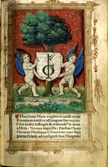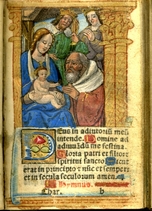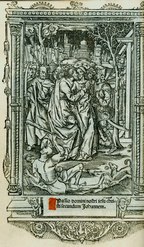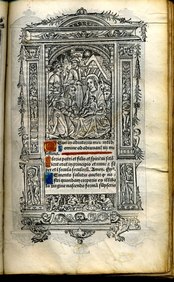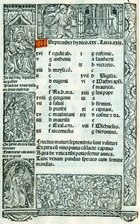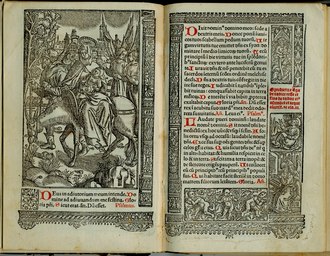Books of Hours printed
The invention of printing in the mid-fifteenth century, allowed the serial reproduction of volumes making them available to a wider audience.
The printing shops offering various types of Books of Hours which can be summarized into three types:
- Printed on vellum with illuminated illustrations
- Printed on vellum with illuminated initials
- Printed on paper
The volumes of the first category, are almost indistinguishable from the manuscripts, only the regularity of the texture betrays the presence of the printing press.
The miniatures and decorations use woodcut illustrations below as a preparatory drawing and are executed with brushes. It is hard to distinguish an illuminated woodcut by a miniature; only looking at the page against the light becomes visible beneath the incision.
Similarly the manuscripts, each printed and illuminated Book of Hours is unique. Books of Hours printed on vellum without miniatures were a product rated lower than the first but not of poor quality.
A greater number of engravings and rich borders - with illustrations taked from the Bible and from mitology - made the book a quality product, however, destined to the upper classes.
Paris was the capital of printed books of Hours.
The most famous parisian printers were: Philippe Pigouchet, sometimes associated with Simon Vostre, remembered for printed borders with beautiful dances of death; Thielman Kerver who produced illustrated books of extraordinary quality with beautiful engravings; Antoine Verard, printer of the Grandes Heures, Books of Hours in large size.
The shop with the best known and most production is that of Hardouin brothers.
The Hardouin's workshop dominated the market of printed books of hours, in Paris between 1510 and 1550.
Gillet Hardouin worked primarily as a printer, between 1500 and 1542, and German Hardouin was registered in the Guild of Illuminators under the wording"in art picture peritissimus Literaria," Their seems to be the only company able to produce the entire Book of Hours, from print to illumination, unlike others that had to involve other professionals.
A peculiarity in the books of hours of Hardouin are the borders that do not follow decorative cycles and stories in an organic way. The scenes from the life of Christ, the Saints and the Old Testament was alternating with allegorical decorations, diabolical and fantastic, drawn from nature or from everyday life.
All the workshops that produced volumes still amazed by the extraordinary quality as image sharpness and a perfect layout, given the technology of the time.




